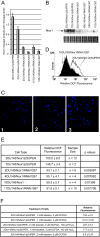Nox1 expression determines cellular reactive oxygen and modulates c-fos-induced growth factor, interleukin-8, and Cav-1
- PMID: 18055552
- PMCID: PMC2111124
- DOI: 10.2353/ajpath.2007.061144
Nox1 expression determines cellular reactive oxygen and modulates c-fos-induced growth factor, interleukin-8, and Cav-1
Abstract
Increased cellular reactive oxygen species (ROS) can act as mitogenic signals in addition to damaging DNA and oxidizing lipids and proteins, implicating ROS in cancer development and progression. To analyze the effects of Nox1 expression and its relation to cellular ROS and signal transduction involved in cellular proliferation, Nox1RNAi constructs were transfected into DU145 prostate cancer cells overexpressing Nox1, causing decreased Nox1 message and protein levels in the Nox1RNAi cell lines. Increased ROS and tumor growth in the Nox1-overexpressing DU145 cells were reversed in the presence of the Nox1RNAi. Analysis and comparison of the message levels in the overexpression and RNAi cells demonstrated that Nox1 overexpression leads to changes in message levels of a variety of proteins including c-fos-induced growth factor, interleukin-8, and Cav-1. Finally, we found that Nox1 protein overexpression is an early event in the development of prostate cancer using a National Cancer Institute prostate cancer tissue microarray (CPCTR). Tumor (86%) was significantly more likely to have Nox1 staining than benign prostate tissue (62%) (P = 0.0001). These studies indicate that Nox1 overexpression may function as a reversible signal for cellular proliferation with relevance for a common human tumor.
Figures



References
-
- Burdon RH. Control of cell proliferation by reactive oxygen species. Biochem Soc Trans. 1996;24:1028–1032. - PubMed
-
- Irani K, Xia Y, Zweier J, Sollott S, Der C, Rearon E, Sundaresan M, Finkel T, Goldschmidt-Clermont P. Mitogenic signaling mediated by oxidants in Ras-transformed fibroblasts. Science. 1997;275:1649–1652. - PubMed
-
- Nonaka Y, Iwagaki H, Kimura T, Fuchimoto S, Orita K. Effect of reactive oxygen intermediates on the in vitro invasive capacity of tumor cells and liver metastasis in mice. Int J Cancer. 1993;54:983–986. - PubMed
-
- Kundu N, Zhang S, Fulton AM. Sublethal oxidative stress inhibits tumor cell adhesion and enhances experimental metastasis of murine mammary carcinoma. Clin Exp Metastasis. 1995;13:16–22. - PubMed
-
- Suh YA, Arnold RS, Lassegue B, Shi J, Xu X, Sorescu D, Chung AB, Griendling KK, Lambeth JD. Cell transformation by the superoxide-generating oxidase Mox1. Nature. 1999;401:79–82. - PubMed
Publication types
MeSH terms
Substances
Grants and funding
LinkOut - more resources
Full Text Sources
Medical

